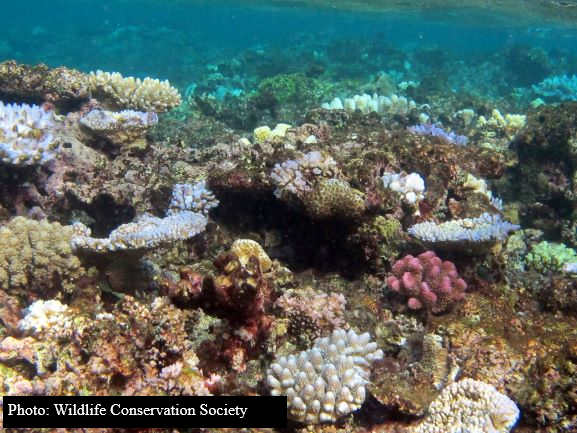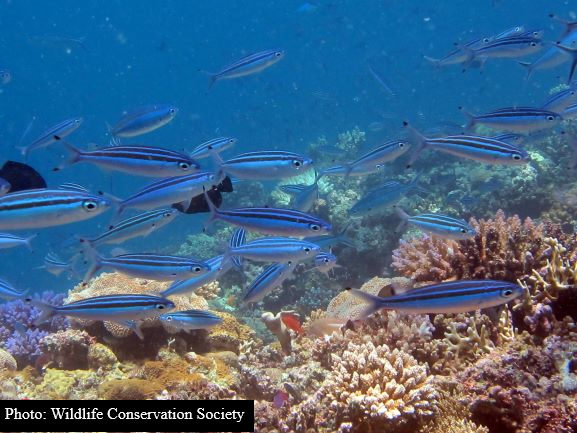As conservationists grapple with unprecedented levels of coral reef bleaching in the world’s warming oceans, scientists in the Indian and Pacific Oceans used the most recent El Nino of 2016 (the warmest year on record) to evaluate the role of excess heat as the leading driver of coral bleaching.
A study titled “Temperature patterns and mechanisms influencing coral bleaching during the 2016 El Niño” has revealed that coral bleaching is not only a result of heat stress but a variety of stressors, which varies between geographies. The study which was led by the Wildlife Conservation Society (WCS) appears in the latest edition of Nature Climate Change.

Coral bleaching generally occurs when corals expel their algae (found within their tissues) when under stress from water temperatures significantly above normal. Reefs closer to the warmer equator have also bleached more in the past and expected to degrade further in 2016.
To find out the extent of bleaching during the 2014-2016 El Nino, 226 sites were assessed from Fiji to East Africa. The study found that different geographic regions responded differently to warm water temperatures, with some reefs suffering bleaching levels of up to 60 percent and others surviving with no impact. The results suggest that coral responses to global climate change may be changing as corals have different past experiences and tolerances to heat and stress.
To determine what other mechanisms lead to coral bleaching, the study evaluated 26 variables and more than 2000 models that were solved by a supercomputer to test the effects of factors such as thermal exposure, depth, habitat, coral community composition, and the types of management used in reef systems. In terms of geography, the researchers found that bleaching depended greatly on where the corals lived along the longitudinal gradient from East Africa to Fiji, with the strongest bleaching observed in East Africa. Consequently, some regions, it seems, will be affected earliest and worse than other regions.

Examining seawater temperatures 90 days before the bleaching, the researchers found that the best predictors of coral bleaching were highest average temperatures, how long cool water endured prior to peak temperatures, and the existence of two peaks in temperature. However, this depended on where the reefs were located, and Fiji and Indonesia’s reefs were less stressed than those in East Africa.
“We know that the Earth’s systems’ responses to climate change are not always straightforward,” said Dr. Stacy Jupiter, WCS Melanesia Regional Director. “These new findings help us untangle some of that complexity so that we can design more effective management to protect coral reefs.”
The widespread coral bleaching in the Indo-Pacific during the most recent El Niño event (2014-2017) was the latest in a series of thermal stresses to impact corals in the region, preceded by events in 1983, 1988, 1998, 2005, 2010, and 2013. The year 2016 brought about the most severe bleaching episodes, including extensive mortality in the Great Barrier Reef.
“The study findings give us hope because Fijian reefs fared better than those in other parts of the world,” said Dr. Sangeeta Mangubhai, WCS Fiji Country Director. “But this does not mean we become complacent. To ensure our reefs have the best chance against future climate change induced bleaching events, we need to make sure that growing human threats such as land based sources of pollution and overfishing are addressed. So let’s all continue to do our part to keep Fiji’s coral reefs as healthy and productive as possible, to give them a fighting chance against climate change.”
The paper is available at: https://www.nature.com/articles/s41558-019-0576-8
The authors of the study are: Tim R. McClanahan; Emily S. Darling; Joseph M. Maina; Nyawira A. Muthiga; Stéphanie D’agata; Stacy D. Jupiter; Rohan Arthur; Shaun K. Wilson; Sangeeta Mangubhai; Yashika Nand; Ali M. Ussi; Austin T. Humphries; Vardhan J. Patankar; Mireille M.M. Guillaume; Sally A. Keith; George Shedrawi; Pagu Julius; Gabriel Grimsditch; January Ndagala; and Julien Leblond.